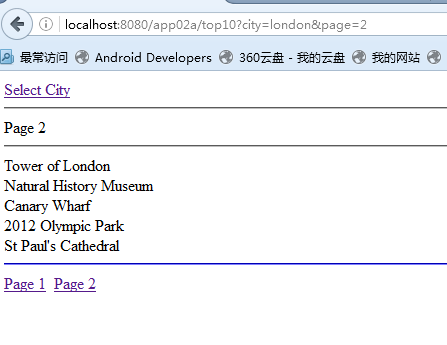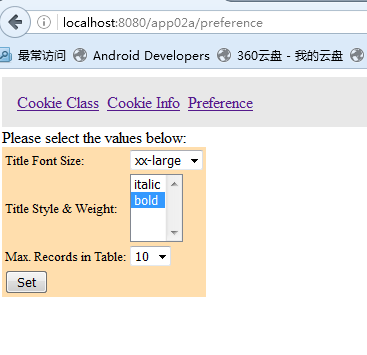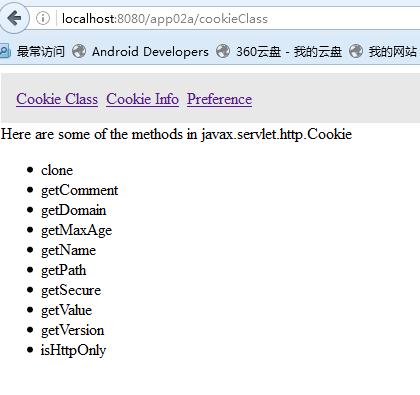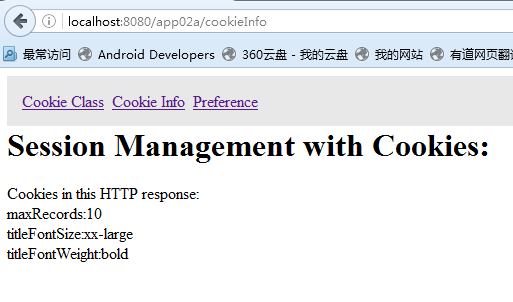與Session的親密接觸&徹底掌握Java中Session Token Cookie
Session管理
Session管理(Session追蹤)是Web應用程式開發中一個非常重要的主題.
本篇文章將重點講解常用的Session管理的四個方法:網址重寫 隱藏域 cookie 及HttpSession物件.
1.網址重寫
網址重寫是一種Session追蹤技術,需要將一個或多個token作為一個查詢字串新增到一個URL中.token的格式是鍵=值.
URL和token之間要用一個問號(?)隔開,兩個token之間用一個&符號隔開.
如果token不必在過多的URL中四處攜帶,那麼網址重寫比較合適.它的缺點如下:
- 有的瀏覽器中,URL限制2000個字元.
- 僅當有連結要插入值時,值才能轉換成後面的資源.此外,不容易將值插入到靜態網頁中.
- 網址重寫必須在伺服器端有效,所有連結都必須帶有值,可能造成一個頁面會有許多連結.
- 空格 &符號及問號都必須進行編碼.
- URL中的資訊是明顯可見的.
網址重寫栗子:
package app02a.urlrewriting;
import java.io.IOException;
import java.io.PrintWriter;
import java.util.ArrayList;
import java.util.List;
import javax.servlet.ServletException;
import javax.servlet.annotation.WebServlet;
import javax.servlet.http.HttpServlet;
import javax.servlet.http.HttpServletRequest;
import 最值得關注的是a標籤的href屬性值,它包含一個問號,接著是token:city=london或著city=paris.任何相對的URL(沒有協議部分的URL)都會被當作是相對於當前頁面的URL,如果點選頁面的某一個超連結,那麼:
或者
就會被髮送到伺服器.
執行效果:
初始頁:
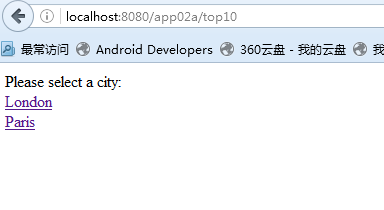
倫敦前十大旅遊地中的第一頁:
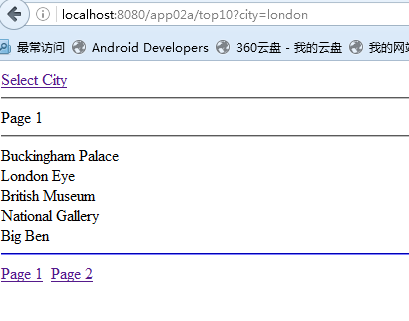
倫敦十大旅遊地的第二頁:
隱藏域
利用隱藏域來儲存狀態,與採用網址重寫技術類似.只是它不把值放到URL後面,而是放到HTML表單的隱藏域中.
優點是: 將更多的字元傳到伺服器,不需要進行字元編碼.
缺點是:只有當要傳遞的資訊不需要跨越多個頁面時,才適合使用這個技術.
隱藏域栗子:
Customer類構建一個客戶模型:
package app02a.hiddenfields;
public class Customer {
private int id;
private String name;
private String city;
public int getId() {
return id;
}
public void setId(int id) {
this.id = id;
}
public String getName() {
return name;
}
public void setName(String name) {
this.name = name;
}
public String getCity() {
return city;
}
public void setCity(String city) {
this.city = city;
}
}利用隱藏域來更新客戶資訊:
package app02a.hiddenfields;
import java.io.IOException;
import java.io.PrintWriter;
import java.util.ArrayList;
import java.util.List;
import javax.servlet.ServletException;
import javax.servlet.annotation.WebServlet;
import javax.servlet.http.HttpServlet;
import javax.servlet.http.HttpServletRequest;
import javax.servlet.http.HttpServletResponse;
/*
* Not thread-safe. For illustration purpose only
*/
@WebServlet(name = "CustomerServlet", urlPatterns = {
"/customer", "/editCustomer", "/updateCustomer"})
public class CustomerServlet extends HttpServlet {
private static final long serialVersionUID = -20L;
private List<Customer> customers = new ArrayList<Customer>();
@Override
public void init() throws ServletException {
Customer customer1 = new Customer();
customer1.setId(1);
customer1.setName("Donald D.");
customer1.setCity("Miami");
customers.add(customer1);
Customer customer2 = new Customer();
customer2.setId(2);
customer2.setName("Mickey M.");
customer2.setCity("Orlando");
customers.add(customer2);
}
private void sendCustomerList(HttpServletResponse response)
throws IOException {
response.setContentType("text/html");
PrintWriter writer = response.getWriter();
writer.println("<html><head><title>Customers</title></head>"
+ "<body><h2>Customers </h2>");
writer.println("<ul>");
for (Customer customer : customers) {
writer.println("<li>" + customer.getName()
+ "(" + customer.getCity() + ") ("
+ "<a href='editCustomer?id=" + customer.getId()
+ "'>edit</a>)");
}
writer.println("</ul>");
writer.println("</body></html>");
}
private Customer getCustomer(int customerId) {
for (Customer customer : customers) {
if (customer.getId() == customerId) {
return customer;
}
}
return null;
}
private void sendEditCustomerForm(HttpServletRequest request,
HttpServletResponse response) throws IOException {
response.setContentType("text/html");
PrintWriter writer = response.getWriter();
int customerId = 0;
try {
customerId =
Integer.parseInt(request.getParameter("id"));
} catch (NumberFormatException e) {
}
Customer customer = getCustomer(customerId);
if (customer != null) {
writer.println("<html><head>"
+ "<title>Edit Customer</title></head>"
+ "<body><h2>Edit Customer</h2>"
+ "<form method='post' "
+ "action='updateCustomer'>");
writer.println("<input type='hidden' name='id' value='"
+ customerId + "'/>");
writer.println("<table>");
writer.println("<tr><td>Name:</td><td>"
+ "<input name='name' value='" +
customer.getName().replaceAll("'", "'")
+ "'/></td></tr>");
writer.println("<tr><td>City:</td><td>"
+ "<input name='city' value='" +
customer.getCity().replaceAll("'", "'")
+ "'/></td></tr>");
writer.println("<tr>"
+ "<td colspan='2' style='text-align:right'>"
+ "<input type='submit' value='Update'/></td>"
+ "</tr>");
writer.println("<tr><td colspan='2'>"
+ "<a href='customer'>Customer List</a>"
+ "</td></tr>");
writer.println("</table>");
writer.println("</form></body>");
} else {
writer.println("No customer found");
}
}
@Override
public void doGet(HttpServletRequest request,
HttpServletResponse response)
throws ServletException, IOException {
String uri = request.getRequestURI();
if (uri.endsWith("/customer")) {
sendCustomerList(response);
} else if (uri.endsWith("/editCustomer")) {
sendEditCustomerForm(request, response);
}
}
@Override
public void doPost(HttpServletRequest request,
HttpServletResponse response)
throws ServletException, IOException {
// update customer
int customerId = 0;
try {
customerId =
Integer.parseInt(request.getParameter("id"));
} catch (NumberFormatException e) {
}
Customer customer = getCustomer(customerId);
if (customer != null) {
customer.setName(request.getParameter("name"));
customer.setCity(request.getParameter("city"));
}
sendCustomerList(response);
}
}執行效果:
客戶列表:
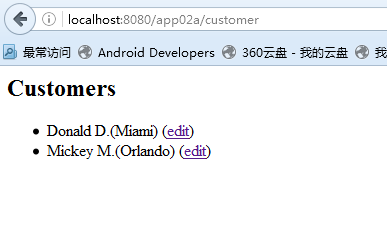
Edit Customer表單:
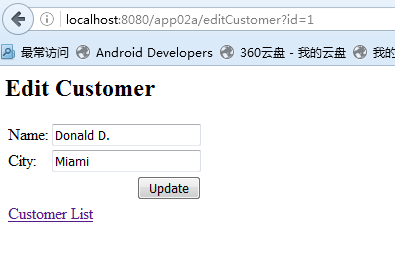
注意到表單中的隱藏域沒有?它包含了customer id,因此當提交表單時,伺服器就會知道正在編輯哪個客戶的資訊
writer.println(“< input type=’hidden’ name=’id’ value=’” + customerId + “’/>”);
cookie
網址重寫和隱藏域都只試用於保持那些不需要跨越許多頁面的資訊.
cookie是自動地在web伺服器與瀏覽器之間來回傳遞的一小塊資訊,需要根據自己的需要來設定cookie的有效期.每臺web伺服器最多可以支援20個cookie.
它存在於javax.servlet.http.Cookie類
Cookie的建立方法:
Cookie cookie=new Cookie(name,value);
建立Cookie之後,要設定它的domain path maxAge屬性,尤其maxAge它是Cookie的有效期.
之後需要用HttpServletResponse呼叫add方法,將Cookie傳送到瀏覽器.
使用HttpServletResponse呼叫getCookies方法獲得Cookie它返回的是Cookie陣列,如果沒有Cookie將返回NULL.
獲取Cookie栗子:
Cookie[] cookies = request.getCookies();
Cookie maxRecordsCookie = null;
if (cookies != null) {
for (Cookie cookie : cookies) {
if (cookie.getName().equals("maxRecords")) {
maxRecordsCookie = cookie;
break;
}
}
}很遺憾,沒有像getCookieByName這樣的方法直接獲取Cookie,更鬧心的是,也沒有直接刪除Cookie的方法.要刪除Cookie需要建立一個同名的Cookie,將它的maxAge屬性設定為0,並在HttpServletResponse中新增一個新的cookie.
刪除Cookie栗子:
Cookie cookie = new Cookie("userName", "");
cookie.setMaxAge(0);
response.addCookie(cookie);接下來寫個完整使用Cookie的栗子:
PreferenceServlet類:
該類的作用是允許使用者修改4個cookie的值,從而在同一個應用程式中設定其他Servlet的顯示設定
package app02a.cookie;
import java.io.IOException;
import java.io.PrintWriter;
import javax.servlet.ServletException;
import javax.servlet.annotation.WebServlet;
import javax.servlet.http.Cookie;
import javax.servlet.http.HttpServlet;
import javax.servlet.http.HttpServletRequest;
import javax.servlet.http.HttpServletResponse;
@WebServlet(name = "PreferenceServlet",
urlPatterns = { "/preference" })
public class PreferenceServlet extends HttpServlet {
private static final long serialVersionUID = 888L;
public static final String MENU =
"<div style='background:#e8e8e8;"
+ "padding:15px'>"
+ "<a href='cookieClass'>Cookie Class</a> "
+ "<a href='cookieInfo'>Cookie Info</a> "
+ "<a href='preference'>Preference</a>" + "</div>";
@Override
public void doGet(HttpServletRequest request,
HttpServletResponse response) throws ServletException,
IOException {
response.setContentType("text/html");
PrintWriter writer = response.getWriter();
writer.print("<html><head>" + "<title>Preference</title>"
+ "<style>table {" + "font-size:small;"
+ "background:NavajoWhite }</style>"
+ "</head><body>"
+ MENU
+ "Please select the values below:"
+ "<form method='post'>"
+ "<table>"
+ "<tr><td>Title Font Size: </td>"
+ "<td><select name='titleFontSize'>"
+ "<option>large</option>"
+ "<option>x-large</option>"
+ "<option>xx-large</option>"
+ "</select></td>"
+ "</tr>"
+ "<tr><td>Title Style & Weight: </td>"
+"<td><select name='titleStyleAndWeight' multiple>"
+ "<option>italic</option>"
+ "<option>bold</option>"
+ "</select></td>"
+ "</tr>"
+ "<tr><td>Max. Records in Table: </td>"
+ "<td><select name='maxRecords'>"
+ "<option>5</option>"
+ "<option>10</option>"
+ "</select></td>"
+ "</tr>"
+ "<tr><td rowspan='2'>"
+ "<input type='submit' value='Set'/></td>"
+ "</tr>"
+ "</table>" + "</form>" + "</body></html>");
}
@Override
public void doPost(HttpServletRequest request,
HttpServletResponse response) throws ServletException,
IOException {
String maxRecords = request.getParameter("maxRecords");
String[] titleStyleAndWeight = request
.getParameterValues("titleStyleAndWeight");
String titleFontSize =
request.getParameter("titleFontSize");
response.addCookie(new Cookie("maxRecords", maxRecords));
response.addCookie(new Cookie("titleFontSize",
titleFontSize));
// delete titleFontWeight and titleFontStyle cookies first
// Delete cookie by adding a cookie with the maxAge = 0;
Cookie cookie = new Cookie("titleFontWeight", "");
cookie.setMaxAge(0);
response.addCookie(cookie);
cookie = new Cookie("titleFontStyle", "");
cookie.setMaxAge(0);
response.addCookie(cookie);
if (titleStyleAndWeight != null) {
for (String style : titleStyleAndWeight) {
if (style.equals("bold")) {
response.addCookie(new
Cookie("titleFontWeight", "bold"));
} else if (style.equals("italic")) {
response.addCookie(new Cookie("titleFontStyle",
"italic"));
}
}
}
response.setContentType("text/html");
PrintWriter writer = response.getWriter();
writer.println("<html><head>" + "<title>Preference</title>"
+ "</head><body>" + MENU
+ "Your preference has been set."
+ "<br/><br/>Max. Records in Table: " + maxRecords
+ "<br/>Title Font Size: " + titleFontSize
+ "<br/>Title Font Style & Weight: ");
// titleStyleAndWeight will be null if none of the options
// was selected
if (titleStyleAndWeight != null) {
writer.println("<ul>");
for (String style : titleStyleAndWeight) {
writer.print("<li>" + style + "</li>");
}
writer.println("</ul>");
}
writer.println("</body></html>");
}
}執行效果:
用cookie管理使用者偏好:
CookieClassServlet類
該類的作用將Cookie類的屬性寫在一個Html列表中,列表中的項編號由maxRecords cookie的值決定.這個值由PreferenceServlet來設定.
package app02a.cookie;
import java.io.IOException;
import java.io.PrintWriter;
import javax.servlet.ServletException;
import javax.servlet.annotation.WebServlet;
import javax.servlet.http.Cookie;
import javax.servlet.http.HttpServlet;
import javax.servlet.http.HttpServletRequest;
import javax.servlet.http.HttpServletResponse;
@WebServlet(name = "CookieClassServlet",
urlPatterns = { "/cookieClass" })
public class CookieClassServlet extends HttpServlet {
private static final long serialVersionUID = 837369L;
private String[] methods = {
"clone", "getComment", "getDomain",
"getMaxAge", "getName", "getPath",
"getSecure", "getValue", "getVersion",
"isHttpOnly", "setComment", "setDomain",
"setHttpOnly", "setMaxAge", "setPath",
"setSecure", "setValue", "setVersion"
};
@Override
public void doGet(HttpServletRequest request,
HttpServletResponse response) throws ServletException,
IOException {
Cookie[] cookies = request.getCookies();
Cookie maxRecordsCookie = null;
if (cookies != null) {
for (Cookie cookie : cookies) {
if (cookie.getName().equals("maxRecords")) {
maxRecordsCookie = cookie;
break;
}
}
}
int maxRecords = 5; // default
if (maxRecordsCookie != null) {
try {
maxRecords = Integer.parseInt(
maxRecordsCookie.getValue());
} catch (NumberFormatException e) {
// do nothing, use maxRecords default value
}
}
response.setContentType("text/html");
PrintWriter writer = response.getWriter();
writer.print("<html><head>" + "<title>Cookie Class</title>"
+ "</head><body>"
+ PreferenceServlet.MENU
+ "<div>Here are some of the methods in " +
"javax.servlet.http.Cookie");
writer.print("<ul>");
for (int i = 0; i < maxRecords; i++) {
writer.print("<li>" + methods[i] + "</li>");
}
writer.print("</ul>");
writer.print("</div></body></html>");
}
}執行效果:
CookieClassServlet的輸出結果:
CookieInfoServlet類:
package app02a.cookie;
import java.io.IOException;
import java.io.PrintWriter;
import javax.servlet.ServletException;
import javax.servlet.annotation.WebServlet;
import javax.servlet.http.Cookie;
import javax.servlet.http.HttpServlet;
import javax.servlet.http.HttpServletRequest;
import javax.servlet.http.HttpServletResponse;
@WebServlet(name = "CookieInfoServlet", urlPatterns = { "/cookieInfo" })
public class CookieInfoServlet extends HttpServlet {
private static final long serialVersionUID = 3829L;
@Override
public void doGet(HttpServletRequest request,
HttpServletResponse response) throws ServletException,
IOException {
Cookie[] cookies = request.getCookies();
StringBuilder styles = new StringBuilder();
styles.append(".title {");
if (cookies != null) {
for (Cookie cookie : cookies) {
String name = cookie.getName();
String value = cookie.getValue();
if (name.equals("titleFontSize")) {
styles.append("font-size:" + value + ";");
} else if (name.equals("titleFontWeight")) {
styles.append("font-weight:" + value + ";");
} else if (name.equals("titleFontStyle")) {
styles.append("font-style:" + value + ";");
}
}
}
styles.append("}");
response.setContentType("text/html");
PrintWriter writer = response.getWriter();
writer.print("<html><head>" + "<title>Cookie Info</title>"
+ "<style>" + styles.toString() + "</style>"
+ "</head><body>" + PreferenceServlet.MENU
+ "<div class='title'>"
+ "Session Management with Cookies:</div>");
writer.print("<div>");
// cookies will be null if there's no cookie
if (cookies == null) {
writer.print("No cookie in this HTTP response.");
} else {
writer.println("<br/>Cookies in this HTTP response:");
for (Cookie cookie : cookies) {
writer.println("<br/>" + cookie.getName() + ":"
+ cookie.getValue());
}
}
writer.print("</div>");
writer.print("</body></html>");
}
}執行效果:
CookieInfoServlet的輸出結果:
Servlet相對路徑和絕對路徑
一、JSP跳轉到Servlet
1、相對路徑,如href=”servlet/TestServlet”
*注意:如果寫成”/servlet/TestServlet”會報錯,因為第一個’/’表示的是【伺服器根目錄:http://localhost:8080/】
2、絕對路徑,通過內建成員變數path實現,如href=”<%=path%>/servlet/TestServlet”。
*注意:這裡的path得到的是專案根目錄,如【http://localhost:8080/Servlet002_GetFormDemo】
二、Servlet跳轉JSP
1、請求重定向:response.sendRedirect(request.getContextPath()+”/xxx.jsp”);這裡通過request.getContextPath()方法獲得專案根目錄,或者通過”../xxx.jsp”取得上層路徑得到
2、伺服器內部轉發:request.getRequestDispatcher(“../xxx.jsp”).forward(req,resp);
*小結:都可以通過../xxx.jsp得到
一、JSP跳轉到Servlet
1、相對路徑,如href=”servlet/TestServlet”
*注意:如果寫成”/servlet/TestServlet”會報錯,因為第一個’/’表示的是【伺服器根目錄:http://localhost:8080/】
2、絕對路徑,通過內建成員變數path實現,如href=”<%=path%>/servlet/TestServlet”。
*注意:這裡的path得到的是專案根目錄,如【http://localhost:8080/Servlet002_GetFormDemo】
二、Servlet跳轉JSP
1、請求重定向:response.sendRedirect(request.getContextPath()+”/xxx.jsp”);這裡通過request.getContextPath()方法獲得專案根目錄,或者通過”../xxx.jsp”取得上層路徑得到
2、伺服器內部轉發:request.getRequestDispatcher(“../xxx.jsp”).forward(req,resp);
*小結:都可以通過../xxx.jsp得到
三、web.xml配置中
< url-pattern>/servlet/HelloWorld < /url-pattern>: url-pattern處必須以 / 開頭,這裡/ 表示專案的根目錄
在Servlet中重定向要使用獲得上下文物件。getContextPath()+”/檔名。jsp”
在Servlet中如果用伺服器跳轉,getRequestDispatcher(“/檔案.jsp”)或者getRequestDispatcher(“../檔案.jsp”)採用逆向思維,獲取當前目錄的上一層目錄
超連結的第一個斜線表示的是伺服器的根目錄;servlet前邊打斜線,表示到根目錄下開啟servlet專案
利用request.getContextpath(),其代表專案的根目錄
url-pattern處的斜線代表專案的根目錄,必須新增
response.sendRedirect當前路徑是ServletPathDirection/servlet/
伺服器內部跳轉,斜線代表專案根目錄
Ps1:路徑字首不寫相當於“./”,如“test.jsp”==“./test.jsp”
Ps2:
Ps3:更新專案名的時候注意,先檢查是否在myeclipse 2015的空間包裡(不是也沒關係其實,最好放在這裡面),然後專案——屬性——MyEclipse——Project Facets——Web——Web Context-root:(伺服器專案名),對應的資料夾在D:\空間名.metadata.me_tcat7\work\Catalina\localhost\Xxx——資料夾名就是伺服器專案名。(注意:修改資料夾名字並不會修改伺服器專案名,而修改Web Context-root才會對伺服器專案名起作用)。若是類似myeclipse8.5的版本,則直接在Tomcat——webapps——專案資料夾名即是Web伺服器專案名,而且修改資料夾名就會影響Web伺服器專案名。
1、伺服器內部跳轉,這裡的斜線表示專案的根目錄
2.請求重定向跳轉,這裡的斜線表示當前目錄
3.超連結和表單跳轉,這裡的第一個斜線表示伺服器根目錄,不加斜線就是當前目錄
4.request.getContextPath();表示當前專案根目錄

